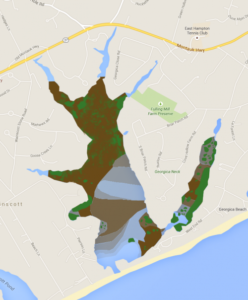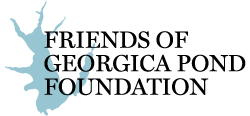Macroalgae. Seaweeds. The visible overgrowth of fleshy plants in aquatic environments. Macroalgae are an important component of any aquatic ecosystem serving as an important food sources and habitat for many animals. Their overgrowth, however, is problematic.
When macroalgae begin to take over an ecosystem, they can shade out other important habitats, lead to dangerously low oxygen levels at night, and can release large quantities of nutrients and organic matter when they die, an occurrence that can trigger further problems with low oxygen or microalgae blooms. Georgica has been historically prone to macroalgae ‘blooms’ and the bloom this year has been exceptionally large. In fact, these macroalgae blooms are precisely why the Georgica Pond Project was initiated: To determine the cause of the blooms and the most likely solutions. Toward that end, last week (June 18), we completed our most recent survey of the macroalgae across the Pond and here are the results:
 Blue regions are free of macroalgae, green regions have macroalgae growing up to the surface of the Pond, brown regions have macroalgae growing on the bottom of the Pond, with dark brown representing full coverage and blends indicating partial coverage. In short, there are macroalgae nearly everywhere, with nearly full coverage in Georgica Cove and the northern half of the Pond but little to no coverage to the south near where the cut had been open. This distribution confirms some of the prior hypotheses regarding the macroalgae: They prefer lower salinity water and are promoted by nutrient loading from land as the regions where they are most abundant have lower salinity which means a higher level of nutrients from streams and groundwater.
Blue regions are free of macroalgae, green regions have macroalgae growing up to the surface of the Pond, brown regions have macroalgae growing on the bottom of the Pond, with dark brown representing full coverage and blends indicating partial coverage. In short, there are macroalgae nearly everywhere, with nearly full coverage in Georgica Cove and the northern half of the Pond but little to no coverage to the south near where the cut had been open. This distribution confirms some of the prior hypotheses regarding the macroalgae: They prefer lower salinity water and are promoted by nutrient loading from land as the regions where they are most abundant have lower salinity which means a higher level of nutrients from streams and groundwater.
As stated above, the Georgica Pond Project has been specifically designed to determine the steps needed to remediate these macroalgae blooms. Here is what is being done: 1. Surveys like the one above are being done biweekly so we can continue to understand the temporal and spatial dynamics of these events, 2. Experiments to determine the specific nutrient or nutrients that are promoting the growth of the macroalgae began in May and continue biweekly, 3. Five nutrient source quantification models for Georgica Pond have been constructed and are being refined. These models will indicate where the nutrients are coming from and what needs to be done to cut-off the supply of nutrients to the macroalgae to limit their proliferation, 4. Water quality monitoring and bathymetric surveys of the Pond will indicate the extent to which other water quality parameters and flushing may be promoting these blooms, and 5. The macroalgae are be analyzed for elemental content and DNA content. On this later point, DNA sequencing of the algae from last year has revealed that the genus and species of the macroalgae in Georgica Pond is Cladophora vagabunda, not Sago pondweed or other types some had speculated it to be. While this may seem like a simple scientific nuisance, this knowledge will greatly alter how remediation will proceed given the preferred habitats of Cladophora vagabunda and Sago pondweed are entirely different.
As all of the above information is progressively gathered, any efforts to remove the macroalgae, specifically the dead and dying part which float on the surface of the Pond, would be beneficial to Georgica Pond. In 2014, these macroalgae eventually died off and may have contributed to later problems such as toxic blue-green algae and low oxygen.
Stay tuned for more updates and you can always watch the data stream in from the buoy!
